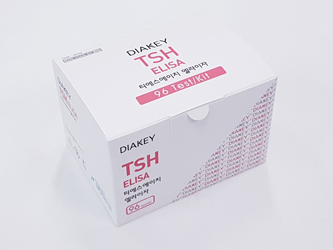
DIAKEY TSH ELISA

| KFDA Registration No : | 14-3220 |
| CAT No : | DET03 |
| TEST METHOD : | ELISA |
| SAMPLE VOLUME : | 25 ul |
| INCUBATION TIME : | 30'+20'RT |
| STD RANGE : | 0-40 uIU/ml |
INTENDED USE : Enzyme immunoassay for quantitative determination of thyroid-stimulating hormone (TSH) in human serum
INTRODUCTION
TSH (Thyroid-stimulating hormone) is a glycoprotein hormone of approximate molecular weight of 28,000 daltons, secreted by the anterior pituitary gland. It consists of two non-covalently bound subunits, known as α and β. The α subunits are very similar in structure, but the β subunits differ markedly in amino acid sequence, and are responsible for the differences in the biological specificity of TSH. The main function of TSH is to develop the thyroid gland and also to stimulate and control the secretion of thyroxine (T4) and triiodothyronine (T3). Increase in serum concentrations of TSH is an early and sensitive indicator of decrease thyroid reserve and in conjunction with decreased T4 concentrations is diagnostic of primary hypothyroidism. The secretion and the liberation of TSH are stimulated by the hypothalamic tripeptide TRH (TSH Releasing Hormone) and are controlled by serum concentrations of the thyroid hormones: T4 and T3 through a negative feedback mechanism: in the thyreotrope cells, T4 is desiodinated in T3 which directly inhibits TSH secretion.
PRINCIPLE OF THE ASSAY
The DIAKEY TSH EIA is a solid-phase, non-competitive immunoassay based upon the sandwich technique. Two different monoclonal TSH antibodies are used. One antibody is coated on solid phase coated plate, the other, specific for the TSH and labeled with HRPO, is used as a conjugate. The conjugate antibody and the coated antibody react simultaneously with the TSH antigen present in the standards, controls and samples. Unbounded material is removed by a washing step. After washing, substrate reagent is added to each well and the enzyme reaction is allowed to proceed. During the enzyme reaction a blue color will develop if antigen is present. The intensity of the color is proportional to the amount of TSH present in the samples. The color intensity is determined in a microplate spectrophotometer at 450nm (reference 620nm).
 HANDLING PRECAUTION
HANDLING PRECAUTION
- Do not use mixed reagents from different lots.
- Do not use reagents beyond the expiration date.
- Use distilled water stored in clean container.
- Use an individual disposable tip for each sample and reagent, to prevent the possible cross-contamination among the samples.
- Rapidly dispense reagents during the assay, not to let wells dry out.
 USE PRECAUTION
USE PRECAUTION
- Wear disposable globes while handling the kit reagents and wash hands thoroughly afterwards.
- Do not pipette by mouth.
- Do not smoke, eat or drink in areas where specimens or kit reagents are handle.
- Handle samples, reagents and loboratory equipments used for assy with extreme care, as they may potentially contain infectious agents.
- When samples or reagents happen to be spilt, wash carefully with a 1% sodium hypochlorite solution.
- Dispose of this cleaning liquid and also such used washing cloth or tissue paper with care, as they may also contain infectious agents.
- Avoid microbial contamination when the reagent vial be eventually opend or the contents be handled.
- Use only for IN VITRO.